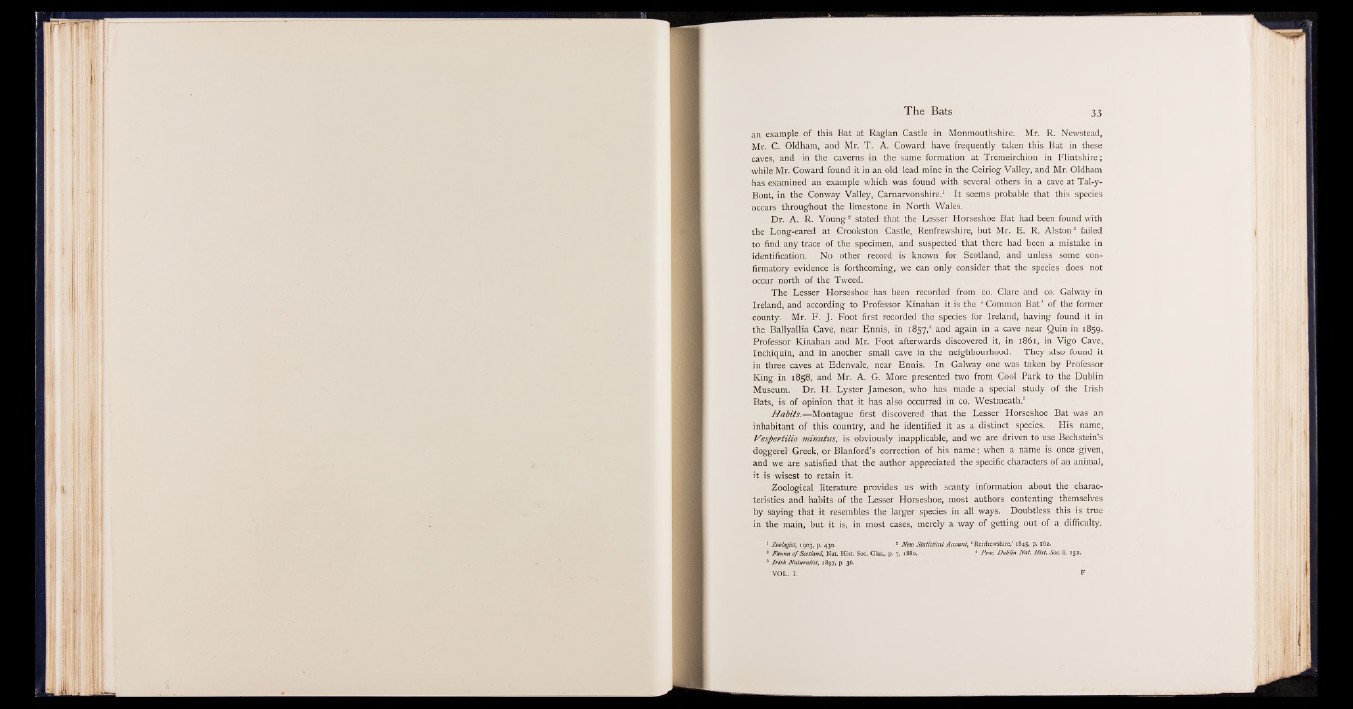
an example of this Bat at Raglan Castle in Monmouthshire. Mr. R. Newstead,
Mr. C. Oldham, and Mr. T. A. Coward have frequently taken this Bat in these
caves, and in the caverns in the same formation at Tremeirchion in Flintshire;
while Mr. Coward found it in an old lead mine in the Ceiriog Valley, and Mr. Oldham
has examined an example which was found with several others in a cave at Tal-y-
Bont, in the Conway Valley, Carnarvonshire.1 It seems probable that this species
occurs throughout the limestone in North Wales.
Dr. A. R. Young2 stated that the Lesser Horseshoe Bat had been found with
the Long-eared at Crookston Castle, Renfrewshire, but Mr. E. R. Alston8 failed
to find any trace of the specimen, and suspected that there had been a mistake in
identification. No other record is known for Scotland, and unless some confirmatory
evidence is forthcoming, we can only consider that the species does not
occur north of the Tweed.
The Lesser Horseshoe has been recorded from co. Clare and co. Galway in
Ireland, and according to Professor Kinahan it is the ‘ Common Bat' of the former
county. Mr. F. J. Foot first recorded the species for Ireland, having found it in
the Ballyallia Cave, near Ennis, in 1857,4 and again in a cave near Quin in 1859.
Professor Kinahan and Mr. Foot afterwards discovered it, in 1861, in Vigo Cave,
Inchiquin, and in another small cave in the neighbourhood. They also found it
in three caves at Eden vale, near Ennis. In Galway one was taken by Professor
King in 1858, and Mr. A. G. More presented two from Cool Park to the Dublin
Museum. Dr. H. Lyster Jameson, who has made a special study of the Irish
Bats, is of opinion that it has also occurred in co. Westmeath.5
Habits.— Montague first discovered that the Lesser Horseshoe Bat was an
inhabitant of this country, and he identified it as a distinct species. His name,
Vespertilio minutus, is obviously inapplicable, and we are driven to use Bechstein’s
doggerel Greek, or Blanford’s correction of his name; when a name is once given,
and we are satisfied that the author appreciated the specific characters of an animal,
it is wisest to retain it.
Zoological literature provides us with scanty information about the characteristics
and habits of the Lesser Horseshoe, most authors contenting themselves
by saying that it resembles the larger species in all ways. Doubtless this is true
in the main, but it is, in most cases, merely a way of getting out of a difficulty.
1 Zoologist, 1903, p. 430. * New Statistical Account, ‘ Renfrewshire,’ 1845, p. 162.
8 Fauna o f Scotland, Nat. Hist. Soc. Glas., p. 7, 1880. * Proc. Dublin Nat. H ist. Soc. ii. 152.
8 Irish Naturalist, 1897, p. 36.
VOL. I. F